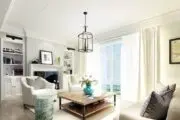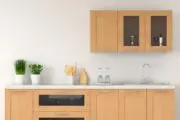
For homeowners seeking inspiration for new builds and renovation projects, often the essential first step in the creative process is scrolling through interior design media, or tuning in to their favorite home makeover show, as much for ideas as for the entertainment of a dramatic big reveal.
The broad-based appeal of these shows typically adheres to a familiar, if not formulaic plotline.
The show host and camera crew tour a home pre-reno, pointing out everything that is “wrong” with the home, from actual structural defects, to dated finishes, floor plans that don’t flow, or even gaudy choices that the homeowners selected in an apparent moment of decorative weakness.
Usually there is a financial component as well, where the host does the math on the asset value of a home before and after the advised renovations, almost always with a solid return on investment.
It’s within this formula that things get complicated for the homeowners watching from the comfort of their own, uniquely styled homes.
These shows, and design media in general, seemingly set the aesthetic standard by which all homes are compared. Inevitably, homeowners scrutinize their own homes accordingly.
Once that bar has been set, propped up with very specific design elements and finishes, there is an implication that there is a “right” or “wrong” way to style and design your home, creating a culture of judgement.
This is at odds with what traditionally home has meant to homeowners for generations; that owning a home is an investment and is a deeply personal space that you can design and decorate according to taste and lifestyle.
A cultural shift around the concept of home
As a new study reveals, homeowners tune into these shows as much for affirmation as they do for inspiration, which is problematic on a few levels.
The research paper, entitled Dysplacement and the Professionalization of the Home, looks at the changing cultural perception around home and what it now represents for homeowners.
The study revealed that a combination of professionalization pushed by design media and growing financialization of real estate, has led to a mass movement towards de-personalization in the marketplace, which is fundamentally disorienting to homeowners, who historically have associated identity with home (or technically, with place).
According to one of the study’s authors, Annetta Grant, assistant professor of markets, innovation and design, at Bucknell University in Lewisburg, Pennsylvania, homeowners, deluged with messages from design media, end up feeling inadequate.
She found in their research that homeowners, following the plotlines of these shows, look at the homes in question through the lens of deficiencies, and then quickly pivot to applying the same scrutiny to their own homes.
Grant says that many of the participants in her study, say things along the lines of, “I would be embarrassed to live here, if this was my house, or too embarrassed to invite any friends over.”
“We found that media was creating a culture of judgment,” says Grant.
“What we found is that when people do renovations, they’re doing renovations with an eye to what does everyone else wants or thinks. Overall, what we found was that, as a result, homeowners feel uneasy in their own homes,” she says.
Additionally, this creates a renovation treadmill, where a home never feels quite finished for homeowners, according to Grant, in part because of the pace and evolution of trends.
And with so many homeowners adopting the standards presented to them by design media, homes risk becoming ubiquitous.
“Homes are being designed for everyone and no one all at once,” says Grant.
Some common style standards, according to Grant, were chef’s kitchens with industrial-style appliances, spa-like bathrooms and a general neutrality with colors and finishes.
A growing awareness of the financial value of home
One of the points of tension for homeowners, explains Grant, is the simultaneous opportunity to renovate and increase the financial value of the home, but also the belief that their design and decor choices will either help or hurt their bottom line.
In short, make the right choices, or leave money on the table.
In the interviews she conducted, Grant says that it was common for homeowners to agonize over small details as a result because of the perceived financial implications and concern if their homes would live up to the expectations of others.
One of the greatest paradoxes of the study was what homeowners stated was the motivation (or justification) for their renovations and decor choices, to what actually unfolded post-project.
The study participants commonly mentioned maximizing financial assets, yet most indicated that they did not intend to sell in the near future, keeping in mind that many renovations are time-limited to the trend cycle.
“The people I interviewed were excited about increasing their financial assets, but also at the same time saying, ‘We really don’t have any plans to sell the home because, we’re doing all these renovations so we can host our family more often,’” among other uses, says Grant.
Do current trends for bold color signal a change?
Current trends seem to eschew some of the standards previously set by interior design media, with the re-introduction of color into the home in a big way, and an open invitation to personalize spaces through micro-trends, such as dopamine decor that embodies an anything-goes aesthetic.
While self-expression is encouraged, there is still a measure of restraint, as looking for affirmation is still a major factor in design choices.
Even though the trend is to be bold with colors, “that’s still a form of standardization. There’s still this idea that they have to be the ‘right’ bold colors,” says Grant.
Striking a balance between personal style and meeting the standard
Homeowners can try to balance out the opportunity for self-expression and appease their desire to meet style standards and keep options open, with future buyers in mind.
The first step is to recognize the inspirational and aspirational role of interior design media as opposed to using it as a measure of success.
In terms of personalizing, the common advice is for homeowners to stay relatively neutral with structural or architectural features, because these are more costly and time-consuming to swap out.
Instead, use accents and decor to introduce color and patterns to a space. It’s not as big a commitment and can be changed easily.
This was a common approach for participants in Grant’s study, “after the bones of standardization were in place”.
Another popular approach is to confine personalized pockets of a home to less visible spaces, such as the powder or laundry room, or home office.
Or, integrate vintage or sentimental pieces into the overall design, starting the design around or from the piece, so that the overall look is cohesive.







